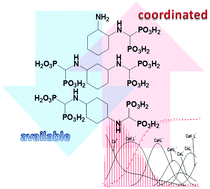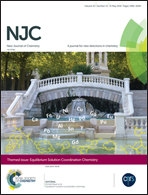Aminobisphosphonates based on cyclohexane backbone as coordinating agents for metal ions. Thermodynamic, spectroscopic and biological studies†
Abstract
Single and double amino-bisphosphonates were synthesized and tested for coordination capabilities towards Ca2+, Mg2+, Cu2+ and Ni2+ metal ions by means of potentiometry, UV-vis spectroscopy, mass spectrometry (ESI-MS) and isothermal titration calorimetry (ITC), as well as for cytotoxic activity by MTT [(3-(4,5-dimethylthiazol-2-yl)-2,5-diphenyltetrazolium bromide)] assay. Half minimal inhibitory concentrations (IC50) were determined with respect to two cell lines (human melanoma A375 and human colorectal adenocarcinoma HT29). Basing the structure of compounds on a cyclohexane ring allowed for a slight reduction of high hydrophilic character of the studied bisphosphonates (BPs). The ligands efficiently bind the examined metal ions forming complex equilibria with diversified stoichiometry of equimolar, polynuclear species and biscomplexes. Both ligands as well as their Ca2+ and Mg2+ complexes show selective antiproliferative activity toward the studied cancer cell lines. Given the thermodynamic and biological data, it can be assumed that ligands are good candidates for linking compounds that may be used in the design of new drug delivery systems. In this approach, one bisphosphonate moiety acts as a bone-targeting molecule, while another molecule can be readily attached to the second donor function (primary amine or bisphosphonate).

- This article is part of the themed collection: Equilibrium Solution Coordination Chemistry


 Please wait while we load your content...
Please wait while we load your content...